snmp网络管理协议基础知识
SNMP(简单网络管理协议)的原理与管理技巧

SNMP(简单网络管理协议)的原理与管理技巧SNMP(Simple Network Management Protocol),即简单网络管理协议,是一种用于网络管理的标准协议。
它被广泛应用于计算机网络中,用于监控和管理网络设备,提供网络的可靠性和可用性,并及时发现和解决网络故障。
本文将介绍SNMP的原理和管理技巧,并提供相关实例,旨在帮助读者更好地理解和应用SNMP。
1. SNMP的基本原理SNMP是一种应用层协议,基于客户-服务器模型。
它主要由管理系统(Manager)和被管理设备(Agent)组成。
管理系统负责监控和管理设备,而被管理设备则向管理系统提供相关的信息。
SNMP的工作原理是通过管理系统发送请求(GetRequest)到被管理设备的Agent,Agent收到请求后,会根据请求返回相应的信息。
管理系统可以通过设置(Set)请求来修改被管理设备的配置参数,也可以通过陷阱(Trap)机制,实现对网络故障的监测和通知。
2. SNMP的管理技巧2.1 合理选择SNMP版本SNMP有多个版本,其中最常用的是SNMPv1、SNMPv2c和SNMPv3。
不同版本的SNMP在安全性、功能和扩展性上有所差异。
在选择SNMP版本时,需要根据实际需求进行权衡。
2.2 配置网络设备的SNMP代理要实现对网络设备的监控和管理,首先需要在被管理设备上配置SNMP代理。
通过设置SNMP代理,可以定义设备的基本信息、访问控制列表、陷阱接收者等,从而提供给管理系统有效的信息。
2.3 合理使用SNMP的命令和对象SNMP提供了丰富的命令和对象,管理系统可以通过这些命令和对象获取设备的状态和配置信息。
在使用这些命令和对象时,需要根据实际情况选择合适的命令,并了解各个对象的具体含义和取值范围。
2.4 合理配置SNMP的告警和陷阱SNMP的陷阱机制可以实现对网络故障的主动监测和通知。
为了及时发现和解决问题,需要合理配置SNMP的告警和陷阱功能。
SNMP协议详解
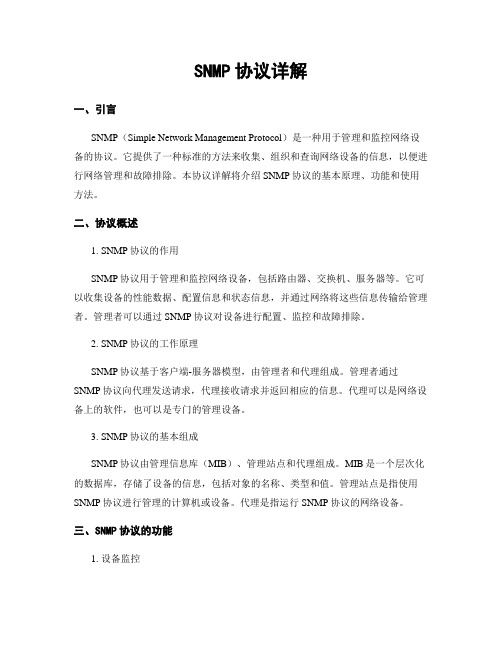
SNMP协议详解一、引言SNMP(Simple Network Management Protocol)是一种用于管理和监控网络设备的协议。
它提供了一种标准的方法来收集、组织和查询网络设备的信息,以便进行网络管理和故障排除。
本协议详解将介绍SNMP协议的基本原理、功能和使用方法。
二、协议概述1. SNMP协议的作用SNMP协议用于管理和监控网络设备,包括路由器、交换机、服务器等。
它可以收集设备的性能数据、配置信息和状态信息,并通过网络将这些信息传输给管理者。
管理者可以通过SNMP协议对设备进行配置、监控和故障排除。
2. SNMP协议的工作原理SNMP协议基于客户端-服务器模型,由管理者和代理组成。
管理者通过SNMP协议向代理发送请求,代理接收请求并返回相应的信息。
代理可以是网络设备上的软件,也可以是专门的管理设备。
3. SNMP协议的基本组成SNMP协议由管理信息库(MIB)、管理站点和代理组成。
MIB是一个层次化的数据库,存储了设备的信息,包括对象的名称、类型和值。
管理站点是指使用SNMP协议进行管理的计算机或设备。
代理是指运行SNMP协议的网络设备。
三、SNMP协议的功能1. 设备监控SNMP协议可以收集设备的性能数据,如CPU利用率、内存使用率和网络流量等。
管理者可以通过监控这些数据来了解设备的运行状态,及时发现问题并采取措施。
2. 设备配置SNMP协议可以通过远程配置设备的参数和选项,如IP地址、路由表和访问控制列表等。
管理者可以通过SNMP协议对设备进行灵活的配置,提高网络的可管理性和安全性。
3. 故障排除SNMP协议可以提供设备的状态信息,如接口的状态、错误计数和日志信息等。
管理者可以通过分析这些信息来定位和解决网络故障,缩短故障恢复时间。
四、SNMP协议的使用方法1. SNMP版本SNMP协议有多个版本,包括SNMPv1、SNMPv2c和SNMPv3。
SNMPv1是最早的版本,具有较弱的安全性和功能。
SNMP协议详解

SNMP协议详解一、介绍SNMP(Simple Network Management Protocol,简单网络管理协议)是一种用于管理和监控网络设备的标准协议。
它允许网络管理员通过网络收集设备的状态信息、配置设备参数、监控网络性能等。
SNMP协议基于客户端-服务器模型,其中网络设备充当服务器,而网络管理系统充当客户端。
二、协议结构SNMP协议由以下组件组成:1. SNMP管理站点(NMS):NMS是网络管理员用于管理和监控网络设备的工具。
它可以发送SNMP请求到网络设备,然后接收和处理设备返回的SNMP响应。
2. 管理信息库(MIB):MIB是一种数据库,用于存储网络设备的配置和状态信息。
MIB使用层次结构来组织数据,每个数据项都有一个唯一的标识符。
3. 网络设备:网络设备包括交换机、路由器、防火墙等。
这些设备可以通过SNMP协议与NMS进行通信。
4. SNMP协议引擎:SNMP协议引擎是网络设备上的软件模块,负责处理SNMP请求和生成SNMP响应。
三、SNMP操作SNMP定义了以下几种操作:1. GET:NMS向网络设备发送GET请求,以获取设备的某个或多个数据项的值。
2. SET:NMS向网络设备发送SET请求,以修改设备的某个或多个数据项的值。
3. GETNEXT:NMS向网络设备发送GETNEXT请求,以获取MIB中的下一个数据项的值。
4. GETBULK:NMS向网络设备发送GETBULK请求,以获取MIB中的多个数据项的值。
5. TRAP:网络设备在发生特定事件时,可以向NMS发送TRAP消息,以通知管理员。
四、MIB结构MIB使用OID(Object Identifier,对象标识符)来标识每个数据项。
OID由一系列数字组成,每个数字表示一个层级。
OID的根节点是iso(1),其下面是org (3),然后是dod(6),接着是internet(1),最后是private(4)。
私有MIB 通常以1.3.6.1.4开头。
SNMP协议详解
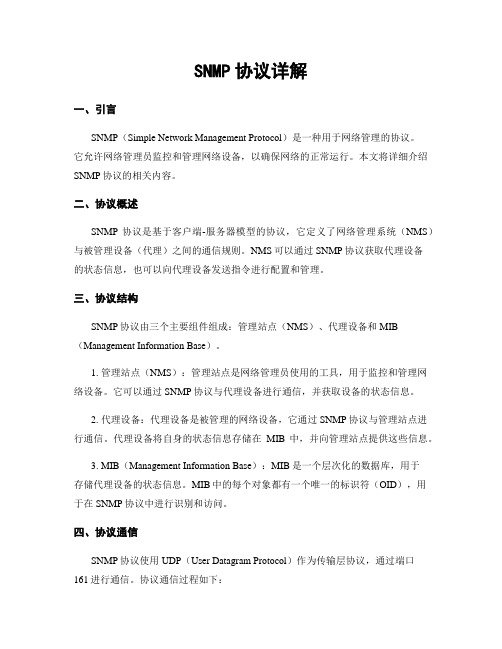
SNMP协议详解一、引言SNMP(Simple Network Management Protocol)是一种用于网络管理的协议。
它允许网络管理员监控和管理网络设备,以确保网络的正常运行。
本文将详细介绍SNMP协议的相关内容。
二、协议概述SNMP协议是基于客户端-服务器模型的协议,它定义了网络管理系统(NMS)与被管理设备(代理)之间的通信规则。
NMS可以通过SNMP协议获取代理设备的状态信息,也可以向代理设备发送指令进行配置和管理。
三、协议结构SNMP协议由三个主要组件组成:管理站点(NMS)、代理设备和MIB (Management Information Base)。
1. 管理站点(NMS):管理站点是网络管理员使用的工具,用于监控和管理网络设备。
它可以通过SNMP协议与代理设备进行通信,并获取设备的状态信息。
2. 代理设备:代理设备是被管理的网络设备,它通过SNMP协议与管理站点进行通信。
代理设备将自身的状态信息存储在MIB中,并向管理站点提供这些信息。
3. MIB(Management Information Base):MIB是一个层次化的数据库,用于存储代理设备的状态信息。
MIB中的每个对象都有一个唯一的标识符(OID),用于在SNMP协议中进行识别和访问。
四、协议通信SNMP协议使用UDP(User Datagram Protocol)作为传输层协议,通过端口161进行通信。
协议通信过程如下:1. 管理站点向代理设备发送请求(GetRequest、GetNextRequest、SetRequest 等),请求的内容包括要获取或设置的MIB对象的OID。
2. 代理设备接收到请求后,根据请求的内容进行相应的处理。
如果是GetRequest请求,代理设备将请求的MIB对象的值返回给管理站点;如果是SetRequest请求,代理设备将设置相应的MIB对象的值。
3. 管理站点接收到代理设备的响应后,根据响应的内容进行相应的处理。
SNMP协议

1.SNMP协议的概述SNMP(Simple Network Management Protocol)是一种用于网络管理的应用层协议。
它允许网络管理员监控和管理网络设备、系统和应用程序,以确保它们正常运行并及时发现和解决问题。
1.1SNMP的作用和重要性SNMP协议在网络管理中扮演着重要的角色,它提供了以下功能:•监控:SNMP允许管理员实时监视网络设备的状态和性能指标,如带宽利用率、CPU负载、内存使用情况等。
•配置管理:管理员可以通过SNMP协议配置网络设备的参数和设置,例如路由器、交换机的端口配置。
•故障诊断:SNMP允许管理员检测和诊断网络设备和系统中的故障,以便及时采取措施进行修复。
•警报和通知:SNMP可以发送警报和通知给管理员,以便在网络出现问题或达到预设的阈值时及时采取行动。
1.2SNMP的工作原理SNMP采用客户端‑服务器模型,其中网络设备(如路由器、交换机)充当SNMP代理,而网络管理系统(NMS)则充当SNMP管理器。
基本的工作原理包括:1.管理器发送SNMP请求到代理设备。
2.代理设备接收请求并根据请求类型执行相应的操作。
3.代理设备将执行结果作为响应发送回管理器。
4.管理器接收响应并解析结果,以便进行适当的管理操作。
1.3SNMP的协议结构SNMP协议采用了基于对象的管理模型,其中管理信息由管理信息库(MIB)定义。
MIB是一个层次化的数据库,包含了网络设备和系统的各种参数和状态信息。
SNMP协议定义了四个主要的操作:•GET:用于获取指定对象的值。
•SET:用于设置指定对象的值。
•GET‑NEXT:用于获取下一个对象的值。
•TRAP:用于代理设备向管理器发送警报和通知。
1.4SNMP的版本和特性SNMP有不同的版本,最常用的版本包括SNMPv1、SNMPv2c和SNMPv3。
每个版本都具有不同的特性和安全性级别。
•SNMPv1:最早的版本,提供基本的网络管理功能,但安全性较弱。
SNMP协议详解

SNMP协议详解一、介绍SNMP(Simple Network Management Protocol)是一种用于网络管理的协议,它提供了一种标准的方式来监控和管理网络设备。
SNMP协议允许网络管理员远程监视和控制网络设备,以确保网络的正常运行和性能优化。
本协议详解将介绍SNMP协议的基本原理、架构、消息格式以及常见的SNMP操作。
二、SNMP协议架构SNMP协议基于客户端-服务器模型,其中网络设备(如路由器、交换机、服务器等)充当服务器,而网络管理系统(NMS)充当客户端。
SNMP协议定义了四个主要组件:管理站点(Manager)、代理(Agent)、管理信息库(MIB)和网络设备。
1. 管理站点(Manager):管理站点是网络管理系统的一部分,负责监控和控制网络设备。
管理站点可以通过SNMP协议向代理发送请求,并接收代理返回的响应。
2. 代理(Agent):代理是网络设备上运行的软件模块,负责收集和存储网络设备的管理信息,并响应管理站点的请求。
3. 管理信息库(MIB):MIB是一种层次化的数据库,用于存储和描述网络设备的管理信息。
MIB定义了一系列的对象标识符(OID),每个OID对应一个特定的管理信息。
4. 网络设备:网络设备指的是需要被监控和管理的设备,如路由器、交换机、服务器等。
网络设备通过代理与管理站点进行通信。
三、SNMP消息格式SNMP协议使用简单的消息格式进行通信,包括两种类型的消息:管理请求消息和代理响应消息。
1. 管理请求消息:管理请求消息由管理站点发送给代理,用于请求特定的管理操作。
管理请求消息包括以下字段:- 版本号:指定SNMP协议的版本。
- 社区名:用于身份验证和访问控制。
- PDU类型:指定请求的操作类型,如获取、设置、通知等。
- 对象标识符(OID):指定要操作的管理信息。
- 值:指定要设置的值(仅在设置操作时使用)。
2. 代理响应消息:代理响应消息由代理发送给管理站点,用于响应管理请求。
简单网络管理协议(SNMP)学习理解
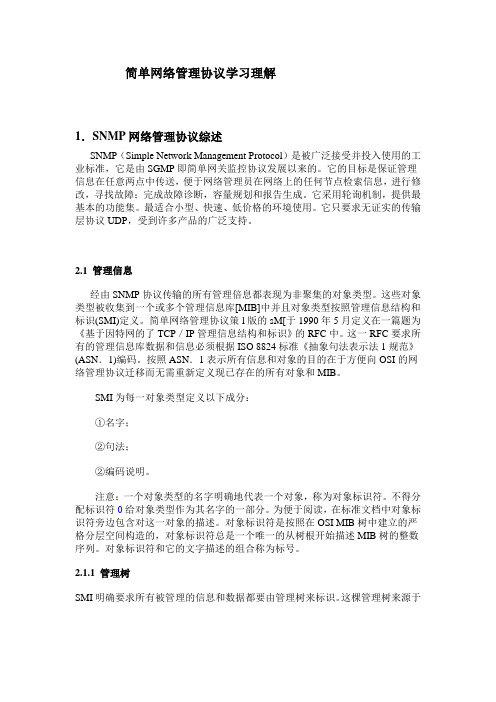
简单网络管理协议学习理解1.SNMP网络管理协议综述SNMP(Simple Network Management Protocol)是被广泛接受并投入使用的工业标准,它是由SGMP即简单网关监控协议发展以来的。
它的目标是保证管理信息在任意两点中传送,便于网络管理员在网络上的任何节点检索信息,进行修改,寻找故障;完成故障诊断,容量规划和报告生成。
它采用轮询机制,提供最基本的功能集。
最适合小型、快速、低价格的环境使用。
它只要求无证实的传输层协议UDP,受到许多产品的广泛支持。
2.1 管理信息经由SNMP协议传输的所有管理倍息都表现为非聚集的对象类型。
这些对象类型被收集到一个或多个管理信息库[MIB]中并且对象类型按照管理信息结构和标识(SMI)定义。
简单网络管理协议策l版的sM[于1990年5月定义在一篇题为《基于因特网的了TCP/IP管理信息结构和标识》的RFC中。
这一RFC要求所有的管理信息库数据和信息必须根据ISO 8824标准《抽象句法表示法1规范》(ASN.1)编码。
按照ASN.1表示所有信息和对象的目的在于方便向OSI的网络管理协议迁移而无需重新定义现已存在的所有对象和MIB。
SMI为每一对象类型定义以下成分:①名字;②句法;②编码说明。
注意:一个对象类型的名字明确地代表一个对象,称为对象标识符。
不得分配标识符0给对象类型作为其名字的一部分。
为便于阅读,在标准文档中对象标识符旁边包含对这一对象的描述。
对象标识符是按照在OSI MIB树中建立的严格分层空间构造的,对象标识符总是一个唯一的从树根开始描述MIB树的整数序列。
对象标识符和它的文字描述的组合称为标号。
2.1.1 管理树SMI明确要求所有被管理的信息和数据都要由管理树来标识。
这棵管理树来源于OSI的定义,它具有从很开始的严格分层化结构。
管理拷的分支和叶子是用数字和字母两种方式显示的。
数字化编码是机器可读的,字母显示则更适合于人的眼睛并帮助用户寻找穿过错综复杂分支的路径。
SNMP协议详解
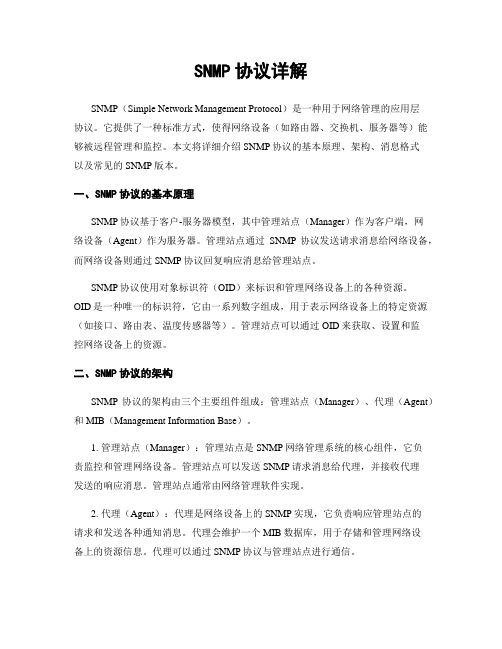
SNMP协议详解SNMP(Simple Network Management Protocol)是一种用于网络管理的应用层协议。
它提供了一种标准方式,使得网络设备(如路由器、交换机、服务器等)能够被远程管理和监控。
本文将详细介绍SNMP协议的基本原理、架构、消息格式以及常见的SNMP版本。
一、SNMP协议的基本原理SNMP协议基于客户-服务器模型,其中管理站点(Manager)作为客户端,网络设备(Agent)作为服务器。
管理站点通过SNMP协议发送请求消息给网络设备,而网络设备则通过SNMP协议回复响应消息给管理站点。
SNMP协议使用对象标识符(OID)来标识和管理网络设备上的各种资源。
OID是一种唯一的标识符,它由一系列数字组成,用于表示网络设备上的特定资源(如接口、路由表、温度传感器等)。
管理站点可以通过OID来获取、设置和监控网络设备上的资源。
二、SNMP协议的架构SNMP协议的架构由三个主要组件组成:管理站点(Manager)、代理(Agent)和MIB(Management Information Base)。
1. 管理站点(Manager):管理站点是SNMP网络管理系统的核心组件,它负责监控和管理网络设备。
管理站点可以发送SNMP请求消息给代理,并接收代理发送的响应消息。
管理站点通常由网络管理软件实现。
2. 代理(Agent):代理是网络设备上的SNMP实现,它负责响应管理站点的请求和发送各种通知消息。
代理会维护一个MIB数据库,用于存储和管理网络设备上的资源信息。
代理可以通过SNMP协议与管理站点进行通信。
3. MIB(Management Information Base):MIB是一种层次化的数据库,用于存储和管理网络设备上的资源信息。
MIB由一系列的对象标识符(OID)组成,每个OID对应一个特定的资源。
MIB定义了资源的属性、操作和关系,管理站点可以通过SNMP协议来访问和操作MIB中的资源。
网络管理(SNMP)
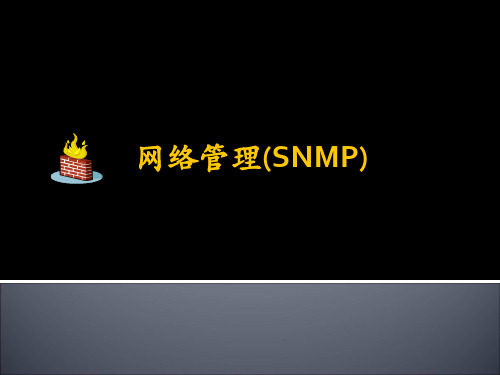
限值就意味着网络的故障
安全管理
安全管理的目标
按照本地的指导来控制对网络资源的访问,以保证网络
不被侵害(有意识或无意识的执行以下几种功能
标识重要的网络资源(包括系统、文件和其他实体)
确定重要的网络资源和用户集间的映射关系
监视对重要网络资源的访问 记录对重要网络资源的非法访问
庞大的网络管理协议,SNMP有5个PDU,而CMIP
有11个PDU。
CMIP也是采用面向对象的技术,这是一种真正 的面向对象技术,一个对象不仅仅有数值,还 有行为,而SNMP则只有数值属性。
公共管理信息协议CMIP(2)
优点
其灵活性和强大的功能,对象由于有行为,它可以更好
地体现被管理网络设施的特性
UDP/TCP
IP
代理进程 SNMP UDP IP
IP 网络接口
委托代理
有时网络管理协议无法控制某些网络元素。
例如,该网络元素使用的是另一种网络管理
协议。这时可使用委托代理(proxy agent)。
委托代理能提供如协议转换和过滤操作的汇 集功能。然后通过委托代理来对被管对象进 行管理。
委托管理的配臵
网络管理主流模式
被管对象
代理
代理
代理 代理
网络的其 他部分
代理 被管对象
MIB 代理 网控中心 非被管对象 代理 被管对象
网管模型
网管模型是指网管系统的组成结构模型。网
管模型解决管理进程和代理进程等管理实体
在网络元素中如何分布的问题。网管模型决
定了网管系统的结构。
当前,网管模型有2个有代表性的模型,即 ISO模型和Internet模型。 ISO和Internet网管
网络管理之SNMP网管协议培训教材

SNMP的通讯方式---SNMP SET
被管资源 管理应用
管理应用对象
SNMP被管对象 SetRequest SNMP Agent
SNMP Manager
SNMP消息
SetRequest UDP IP 依赖于网络的协议 SNMP 管理工作站
网络或互联网络
UDP IP 依赖于网络的协议 SNMP 代理
system interface 2 1
ICMP TCP 5 6
UDP 7
对象标识符--OID
• 对象标识符 (OID): – 对象标识符是能够唯一标识某个对象类型的符号。 – 一个OID包含了一个整数序列, 用于表示在对象标识符树上的具体位置。 0 ccitt 0 std 1 reg authority root 1 iso 2 joint-iso-ccitt
2 member body
1.3.6.1.2.1.2
1 directory mgmt 1 MIB II at 3 IP 4
3 org 6 dod 1 internet 3 2 experimental
1.3.6.1.2.1 1.3.6.1.4.1
4 private 1 enterprises EGP 8 Trans. 10 SNMP 11
Get
Manager
Get Response
Agent
Set
Set Request
Manager
Get Response
Agent
Trap
Manager
Trap Request
Agent
SNMP缺省的UDP端口
Management Station Network Elements (NEs)
SNMP基本理论

记录一一、SNMP基本理论:1.SNMP(简单网络管理协议)是一种网络管理手段,是最流行的标准管理框架,是应用层上的协议,主要通过一组Internet协议及其所依附资源提供网络管理服务(主要用UDP/IP实现Internet上通信)。
他提供了一个基本框架用来实现对鉴别、授权、访问控制,以及网络管理政策实施等的高层管理。
分层协议应用层 Snmp, telnet, ftp传输层 Udp, tcp网络层 ip接入层 Lan ,wan ,man2.SNMP采用“管理进程-代理进程”模型来监视和控制Internet上各种可管理网络设备。
采用提取-存储范例来实现管理进程和代理进程间的网络管理。
3.SNMP是一种已实现的标准网络管理框架。
SNMP参考模型说明了SNMP网络管理框架的一般化总体结构,包括系统中各个组成部分及其相互关系。
SNMP参考模型有四个主要部件构成:互联网络、网络协议、网络管理进程、被管网络实体。
其中:互联网络是采用相同协议、通过网关相连的一个或多个网络的集合。
网络协议是使互连网络能够实现通信的规则。
管理进程和代理进程是进行通信的网络设备。
4.SNMP的局限性1)功能比CMIS/CMIP少 2)有限安全性 3)无管理进程间通信机制 4)缺乏对非INTERNET协议的支持 5)成块数据传输功能弱 6)规模受限5.SNMP的关键特性(优点)1)简单性 2)可扩展性二、SNMP三个主要组成部分:(SMI, SNMP, MIB)SMI: 定义管理对象及管理信息SNMP:信息交换规则MIB:管理对象的集合1.管理信息结构(SMI):为三要素之首,定义了SNMP框架所用信息的组织、组成和标识,也为描述MIB对象和描述协议怎样交换信息奠定了基础。
SMI有两个版本:SMIv1和SMIv2。
SMI的一个基本用途是定义SNMP使用的管理对象,按照SMI定义的SNMP管理对象具有三个属性:名字、语法和编码。
名字(对象标识符):是用点分十进制整数字符串表示,采用层次化模型-全局树表示。
SNMP协议网络设备管理的标准协议

SNMP协议网络设备管理的标准协议SNMP(Simple Network Management Protocol)是一种用于网络设备管理的标准协议。
它允许网络管理员监视和管理网络中的各种设备,如路由器、交换机和服务器等。
SNMP协议提供了一种标准的方法,使网络设备可以通过网络进行监视、配置和故障排除。
一、SNMP协议的基本原理SNMP协议基于客户端/服务器模型运行,其中网络管理系统充当客户端,而网络设备充当服务器。
客户端可以发送请求到服务器获取设备的状态信息,并且可以通过发送命令来配置设备。
SNMP协议使用了一套固定的命令格式,包括GET、SET、GETNEXT和TRAP等,以便进行设备管理和监控。
二、SNMP协议的核心组件1. 管理站(Management Station):管理站是网络管理员用于监视和管理网络设备的工作站。
它可以通过SNMP协议与网络设备进行通信,并获取设备的信息或者修改配置。
2. 设备代理(Agent):设备代理是网络设备中运行SNMP协议的组件。
它负责接收管理站的请求,并将设备的状态信息发送给管理站。
设备代理还能够接收并执行管理站传递的命令,并对设备进行相应的配置。
3. MIB(Management Information Base):MIB是一个存储和管理设备信息的数据库。
它定义了网络设备通过SNMP协议提供的信息的结构和属性。
管理员可以通过查询MIB获取设备的各种状态信息。
三、SNMP协议的工作流程1. 管理站发送GET命令到设备代理,请求获取某个特定OID (Object Identifier)对应的数据。
2. 设备代理接收到GET命令后,查询MIB中对应OID的数据,并将其回复给管理站。
3. 管理站根据接收到的数据进行分析,可以判断设备的状态、性能等相关信息。
四、SNMP协议的应用场景SNMP协议广泛应用于网络管理领域,以下是几个常见的应用场景:1. 故障监测与排除:管理员可以通过SNMP协议实时监控网络设备的运行状态,一旦发生故障,可以及时采取措施进行排查和修复。
SNMP协议详解

SNMP协议详解协议名称:Simple Network Management Protocol(简单网络管理协议)协议版本:SNMPv2c协议描述:SNMP是一种用于网络管理的协议,它允许网络管理员通过网络监控和控制网络设备。
SNMP协议是基于客户端-服务器模型的,其中网络设备被视为服务器,而网络管理员则扮演客户端的角色。
SNMP协议的主要功能包括:1. 监控:通过SNMP协议,网络管理员可以实时监控网络设备的性能和状态。
例如,他们可以监测设备的CPU利用率、内存使用情况、网络流量等指标。
2. 配置:SNMP协议允许网络管理员通过远程配置来管理网络设备。
他们可以更改设备的配置参数,例如IP地址、路由表、访问控制列表等。
3. 故障排除:SNMP协议提供了故障排除功能,网络管理员可以通过查询设备的日志、错误消息和警报来定位和解决网络问题。
4. 安全性:SNMP协议支持安全功能,如身份验证和加密,以确保只有授权的用户可以访问和管理网络设备。
SNMP协议的工作原理如下:1. 管理器(Manager):管理器是网络管理员使用的应用程序或工具,它负责与网络设备进行通信。
管理器发送SNMP消息到代理(Agent)以获取或设置设备的信息。
2. 代理(Agent):代理是安装在网络设备上的软件模块,它负责接收来自管理器的SNMP消息,并根据消息执行相应的操作。
代理将设备的信息存储在管理信息库(MIB)中,并在需要时发送给管理器。
3. 管理信息库(MIB):MIB是一个数据库,它存储了网络设备的管理信息。
MIB由一组命名的对象组成,每个对象都有一个唯一的标识符(OID)。
管理器可以通过OID来访问和管理设备的信息。
SNMP协议的消息格式如下:1. SNMP消息头:包含消息类型(Get、Set、Trap等)和版本号(SNMPv2c)等信息。
2. SNMP消息体:包含请求或响应的数据。
对于Get请求,消息体包含要获取的对象的OID;对于Set请求,消息体包含要设置的对象的OID和值。
SNMP协议详解
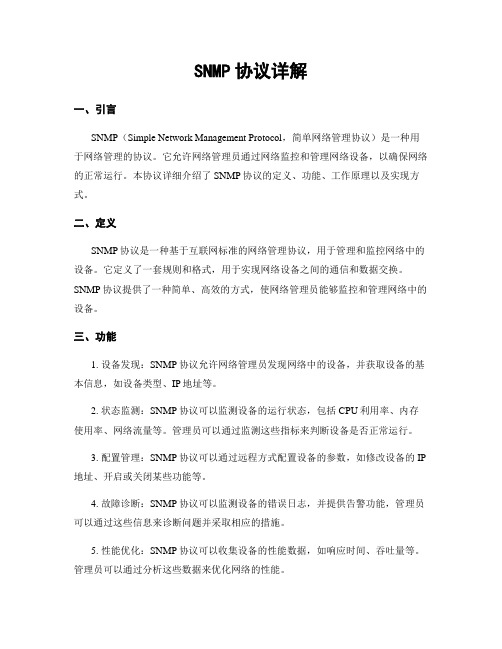
SNMP协议详解一、引言SNMP(Simple Network Management Protocol,简单网络管理协议)是一种用于网络管理的协议。
它允许网络管理员通过网络监控和管理网络设备,以确保网络的正常运行。
本协议详细介绍了SNMP协议的定义、功能、工作原理以及实现方式。
二、定义SNMP协议是一种基于互联网标准的网络管理协议,用于管理和监控网络中的设备。
它定义了一套规则和格式,用于实现网络设备之间的通信和数据交换。
SNMP协议提供了一种简单、高效的方式,使网络管理员能够监控和管理网络中的设备。
三、功能1. 设备发现:SNMP协议允许网络管理员发现网络中的设备,并获取设备的基本信息,如设备类型、IP地址等。
2. 状态监测:SNMP协议可以监测设备的运行状态,包括CPU利用率、内存使用率、网络流量等。
管理员可以通过监测这些指标来判断设备是否正常运行。
3. 配置管理:SNMP协议可以通过远程方式配置设备的参数,如修改设备的IP 地址、开启或关闭某些功能等。
4. 故障诊断:SNMP协议可以监测设备的错误日志,并提供告警功能,管理员可以通过这些信息来诊断问题并采取相应的措施。
5. 性能优化:SNMP协议可以收集设备的性能数据,如响应时间、吞吐量等。
管理员可以通过分析这些数据来优化网络的性能。
四、工作原理SNMP协议基于客户端/服务器模型,包括三个主要组件:管理站点、代理和设备。
管理站点是网络管理员用于监控和管理网络的工作站,代理是网络设备上运行的SNMP软件,设备是需要被管理的网络设备。
1. 管理站点向代理发送请求:管理站点通过SNMP协议向代理发送请求,请求获取设备的信息或执行某些操作。
2. 代理处理请求:代理接收到请求后,根据请求的类型执行相应的操作,如获取设备信息、修改设备配置等。
3. 代理向管理站点发送响应:代理处理完请求后,将结果封装成响应消息,并通过SNMP协议将响应发送回管理站点。
4. 管理站点解析响应:管理站点接收到代理发送的响应后,解析响应消息,并根据需要进行相应的处理。
snmp协议详解

snmp协议详解SNMP(Simple Network Management Protocol)是一种用于网络管理的标准协议。
它允许网络管理员远程监控和管理网络中的设备,例如路由器、交换机、服务器等。
SNMP协议通过网络管理系统(NMS)与网络设备进行通信,从而实现对网络设备的监控和管理。
SNMP协议的核心是管理信息库(MIB),MIB是一种描述网络设备所支持的参数和状态信息的数据库。
通过MIB,网络管理员可以获取设备的各种信息,例如CPU利用率、内存使用情况、接口状态等。
此外,管理员还可以通过SNMP协议对设备进行配置和控制,例如修改路由表、重启设备等操作。
SNMP协议主要由三个部分组成,管理系统、代理和MIB。
管理系统通常是一个专门的网络管理软件,用于监控和管理网络设备。
代理是安装在网络设备上的软件模块,负责收集设备的状态信息,并响应管理系统的请求。
MIB是一个由标准和私有部分组成的数据库,描述了设备所支持的各种参数和状态信息。
在SNMP协议中,有两种类型的消息,GET和SET。
GET消息用于从设备中获取信息,而SET消息用于向设备发送配置命令。
管理系统通过发送GET消息来获取设备的状态信息,然后根据这些信息来进行管理和监控。
而当需要对设备进行配置时,管理系统则会发送SET消息来修改设备的配置参数。
SNMP协议采用了简单的基于UDP的通信方式,它使用端口号161来接收管理系统的请求,并使用端口号162来接收代理的通知。
这种基于UDP的通信方式使得SNMP协议具有了较高的效率和较低的开销,但也带来了一定的不可靠性,因为UDP是一种无连接的协议,无法保证消息的可靠传输。
除了GET和SET消息外,SNMP协议还定义了TRAP消息,用于代理向管理系统发送通知。
当设备发生重要事件时,代理会向管理系统发送TRAP消息,以便及时通知管理员。
这种事件可以是设备的故障、性能下降、安全事件等,管理员可以根据这些通知来及时做出响应。
SNMP协议详解

SNMP协议详解协议概述:Simple Network Management Protocol(简单网络管理协议,SNMP)是一种用于管理和监控网络设备的应用层协议。
它提供了一种标准的方法,使网络管理员能够监控网络设备的状态、收集性能统计数据以及配置网络设备。
协议功能:1. 网络设备的监控和管理:SNMP允许网络管理员监控网络设备的状态,例如路由器、交换机和服务器等。
管理员可以通过SNMP获取设备的基本信息,如设备名称、硬件信息和固件版本等。
2. 性能统计数据的收集:SNMP可以收集网络设备的性能统计数据,如带宽利用率、流量统计和错误报告等。
这些数据对于网络规划和优化非常重要。
3. 配置网络设备:SNMP可以用于配置网络设备的参数,如IP地址、路由表和访问控制列表等。
管理员可以通过SNMP发送命令来修改设备的配置。
协议结构:SNMP协议由两个主要部分组成:管理站和代理代理。
1. 管理站:管理站是网络管理员使用的工具,用于监控和管理网络设备。
管理站可以是一个单独的计算机或一个管理系统。
它通过SNMP协议与代理代理通信,并收集设备信息、发送命令和接收响应。
2. 代理代理:代理代理是网络设备上运行的软件模块,负责响应管理站的请求并提供设备信息。
代理代理可以是路由器、交换机、服务器或其他网络设备。
它们通过SNMP 协议与管理站通信,并根据请求提供设备状态和性能统计数据。
协议操作:SNMP协议定义了一组操作,用于管理站与代理代理之间的通信。
以下是SNMP协议中最常用的操作:1. Get操作:Get操作用于从代理代理获取设备的特定信息。
管理站发送一个Get请求,指定所需的信息,代理代理则返回相应的值。
例如,管理站可以发送一个Get请求来获取设备的名称或接口状态。
2. Set操作:Set操作用于向代理代理发送命令,以配置设备的参数。
管理站发送一个Set请求,指定要修改的参数和新的值,代理代理则根据请求进行相应的配置。
SNMP协议详解

SNMP协议详解协议简介:Simple Network Management Protocol(SNMP)是一种用于网络管理的应用层协议。
它允许管理者监控和控制网络设备,以及收集设备的性能统计信息。
SNMP协议提供了一种标准化的方式,使得不同厂商的网络设备可以被集中管理。
一、SNMP协议的工作原理SNMP协议基于客户-服务器模型,其中有三个主要的角色:SNMP管理器、被管理设备和代理。
1. SNMP管理器(Manager):SNMP管理器是一个网络管理系统,负责监控和控制网络设备。
它可以向被管理设备发送请求,获取设备的状态信息,并对设备进行配置和控制。
SNMP管理器可以是一个单独的应用程序,也可以是一个集成在网络管理系统中的组件。
2. 被管理设备(Agent):被管理设备是指需要被监控和管理的网络设备,如路由器、交换机、服务器等。
被管理设备上运行着一个SNMP代理,负责处理来自SNMP管理器的请求,并返回相应的信息。
被管理设备通常具有各种各样的管理信息库(MIB),用于存储设备的状态信息。
3. 代理(Proxy):代理是一个位于SNMP管理器和被管理设备之间的中间层。
它可以帮助SNMP 管理器与不支持SNMP协议的设备进行通信,或者帮助被管理设备与多个SNMP管理器进行通信。
代理接收来自SNMP管理器的请求,并将其转发给被管理设备,然后将响应返回给SNMP管理器。
二、SNMP协议的消息格式SNMP协议使用一种基于ASN.1(Abstract Syntax Notation One)的消息格式来进行通信。
SNMP消息由两个部分组成:消息头和消息体。
1. 消息头(Message Header):消息头包含了SNMP消息的元数据,如版本号、社区名等。
其中,版本号指定了所使用的SNMP协议的版本,社区名用于身份验证和授权。
2. 消息体(Message Body):消息体包含了SNMP消息的具体内容,如请求类型、对象标识符(OID)等。
网络协议知识:SNMP协议的功能和使用方法

网络协议知识:SNMP协议的功能和使用方法SNMP协议是一种网络管理协议,用于监控网络设备和服务器的状态。
SNMP协议可以通过简单的网络管理协议接口,获取和设置网络设备中的数据。
SNMP协议由两部分组成:管理站和代理。
管理站是网络管理员使用的GUI(图形用户界面)或CLI(命令行界面)界面,用于监控网络设备的状态。
代理是网络设备或服务器上的软件,用于向管理站提供网络设备的状态信息。
SNMP协议的主要功能包括:1.发现网络设备:SNMP协议可以快速发现网络中的设备,包括路由器、交换机、服务器等。
2.接收网络设备状态信息:SNMP协议可以接收网络设备发送的状态信息,包括CPU使用率、内存使用率、磁盘空间利用率、网络带宽利用率等。
3.监控网络设备状态:SNMP协议可以对网络设备的状态进行监控,可以通过设置警报和阈值来检测网络设备的异常状况。
4.远程控制网络设备:SNMP协议可以远程控制网络设备,包括重启设备、配置网络参数、更新软件等。
SNMP协议的使用方法:SNMP协议有三个版本,分别为SNMPv1、SNMPv2和SNMPv3。
不同版本的SNMP协议具有不同的优缺点,在选择使用的版本时需要根据实际情况进行选择。
使用SNMP协议需要满足以下条件:1.网络设备或服务器需要支持SNMP协议。
一些网络设备和服务器默认开启SNMP协议,但有些需要管理员手动开启。
2.需要安装SNMP协议的管理软件,如Zabbix、Nagios等。
这些软件可以对网络设备进行监控和管理,可以自动化地进行异常检测和警报通知。
3.需要进行SNMP协议的配置和管理。
SNMP协议的配置和管理需要管理员掌握一定的网络知识和技能,可以通过学习相关课程和培训来掌握。
SNMP协议的优缺点:SNMP协议的优点是其简单、易用、可靠性高、可扩展性强,可以快速定位网络问题并进行解决。
但同时SNMP协议也存在一些缺点,如易受到攻击、安全性不够高、需要额外的管理软件等。
SNMP网络管理协议的配置与使用

SNMP网络管理协议的配置与使用SNMP(Simple Network Management Protocol)是网络管理协议中广泛使用的一种协议,它可以用来监控网络设备的状态、收集性能数据等。
本文将介绍SNMP协议的基本原理、配置和使用。
SNMP协议的基本原理SNMP协议是基于客户端/服务器模型的协议,主要由三个组成部分组成:管理站、代理和网络设备。
其中,管理站是一个用来管理网络设备的计算机,代理则是安装在网络设备上的软件,它们可以帮助管理站收集和汇总设备的状态和性能数据。
网络设备则是指需要被管理的网络设备,如交换机、路由器等。
在SNMP协议中,管理站将会发出一些命令,代理则可以根据这些命令来获取设备的状态和性能数据,并将其返回给管理站。
这些命令主要包括GET(获取指定的对象)、SET(设置指定的对象)、GETNEXT(获取下一个对象)和GETBULK(获取一组对象)等。
SNMP协议的配置在SNMP协议中,需要完成两个配置:管理站的配置和网络设备的配置。
管理站的配置管理站通常会安装一些SNMP客户端软件,用于连接代理并获取设备的状态和性能数据。
在配置管理站时,需要指定下列信息:1.代理的IP地址和端口号2.团体名或密码团体名或密码是SNMP协议用来进行身份验证和访问控制的重要参数。
在SNMP中,可以有多个团体名,每个团体名都对应了不同的安全级别。
例如,public团体名表示最低安全级别,它允许管理站只读地查看设备上的某些对象,而private则表示一种更高的安全级别,它允许管理站对设备上的某些对象进行读写操作。
网络设备的配置网络设备上也需要安装SNMP代理程序,并进行相应的配置。
在配置网络设备时,需要指定下列信息:1.代理的IP地址和端口号2.团体名或密码3.管理站允许访问的对象列表管理站通常只需要访问设备的一些对象,如设备的CPU利用率、内存使用率等,而不需要访问全部对象。
因此,网络设备需要配置一个允许管理站访问的对象列表,以免管理站访问过多的对象,导致设备性能下降。
- 1、下载文档前请自行甄别文档内容的完整性,平台不提供额外的编辑、内容补充、找答案等附加服务。
- 2、"仅部分预览"的文档,不可在线预览部分如存在完整性等问题,可反馈申请退款(可完整预览的文档不适用该条件!)。
- 3、如文档侵犯您的权益,请联系客服反馈,我们会尽快为您处理(人工客服工作时间:9:00-18:30)。
Nodes
Items in an SNMP Network are called nodes. There are different types of nodes. •Managed nodes
Typically runs an agent process that services requests from a management node
bandwidth increase
SNMP & Network Management History
• • • • • 1983 - TCP/IP replaces ARPANET at U.S. Dept. of Defense, effective birth of Internet First model for net management - HEMS - High-Level Entity Management System (RFCs 1021,1022,1024,1076) 1987 - ISO OSI proposes CMIP - Common Management Information Protocol, and CMOT (CMIP over TCP) for the actual network management protocol for use on the internet Nov. 1987 - SGMP - Simple Gateway Monitoring protocol (RFC 1028) 1989 - Marshall T. Rose heads up SNMP working group to create a common network management framework to be used by both SGMP and CMOT to allow for transition to CMOT Aug. 1989 - “Internet-standard Network Management Framework” defined (RFCs 1065, 1066, 1067) Apr. 1989 - SNMP promoted to recommended status as the de facto TCP/IP network management framework (RFC 1098) June 1989 - IAB committee decides to let SNMP and CMOT develop separately May 1990 - IAB promotes SNMP to a standard protocol with a recommended status (RFC 1157) Mar. 1991 - format of MIBs and traps defined (RFCs 1212, 1215) TCP/IP MIB definition revised to create SNMPv1 (RFC 1213)
•Rules specifying the format used to define objects managed on the network that the SNMP protocol accesses
•Management Information Base (MIB)
•A map of the hierarchical order of all managed objects and how they are accessed
• • • • • •
Versions
•Two major versions SNMPv1, SNMPv2 •SNMPv1 is the recommended standard •SNMPv2 has become split into:
•SNMPv2u - SNMPv2 with user-based security •SNMPv2* - SNMPv2 with user-based security and additional features •SNMPv2c - SNMPv2 without security
Nodes can be both managed nodes and a management node at the same time
(typically this is the case, since you want to be able to manage the workstation that your management application is running on.)
•UDP Port 161 - SNMP Messages •UDP Port 162 - SNMP Trap Messages
The Three Parts of SNMP
SNMP network management is based on three parts: •SNMP Protocol
Ports & UDP
•SNMP uses User Datagram Protocol (UDP) as the transport mechanism for SNMP messages
Ethernet Frame IP Packet CRC
UDP Datagram
SNMP Message
•Like FTP, SNMP uses two well-known ports to operate:
Community Names
Community names are used to define where an SNMP message is destined for. They mirror the same concept as a Windows NT or Unix domain. •Set up your agents to belong to certain communities. •Set up your management applications to monitor and receive traps from certain community names.
What is SNMP?
• SNMP is a tool (protocol) that allows for remote and local management of items on the network including servers, workstations, routers, switches and other managed devices. • Comprised of agents and managers •Agent - process running on each managed node collecting
Advantages of using SNMP
• • • • • • Standardized universally supported extendible portable allows distributed management access lightweight protocol
Client Pull & Server Push
SNMP & The OSI Model
7 Application Layer Management and Agent APIs SNMP 6 Presentation Layer ASN.1 and BER 5 Session Layer RPC and NetBIOS 4 Transport Layer TCP and UDP 3 Network Layer IP and IPX 2 Data Link Layer Ethernet, Token Ring, FDDI 1 Physical Layer
Performance Management - # of packets dropped, timeouts, collisions, CRC errors
Security Management - SNMP doesn’t provide much here Accounting Management - cost management and chargeback assessment
information about the device it is running on.
•Manager - process running on a management workstation that
requests information about devices on the network.
•Fault Management
•Dealing with problems and emergencies in the network (router stops routing, server loses power, etc.)
•Performance Management
•How smoothly is the network running? •Can it handle the workload it currently has?
•Defines format of messages exchanged by management systems and agents. •Specifies the Get, GetNext, Set, and Trap operations
•Structure of Management Information (SMI)
•Management nodes
Typically a workstation running some network management & monitoring software
